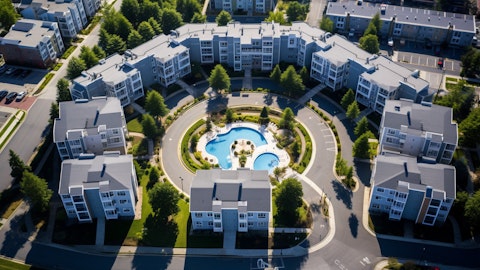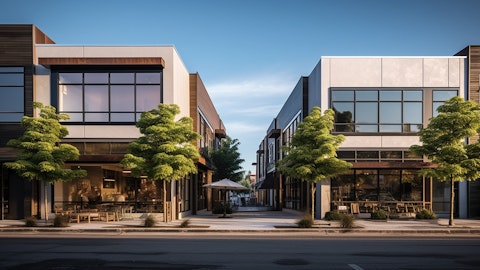Bob Sulentic: I’ll comment on the — Jade on the Trammell Crow Company circumstance and then Emma can comment on the volumes, the financing volumes. We are taking on a steady stream of new land sites in Trammell Crow Company that we’re underwriting at returns that we think based on current cap rates will be consistent with our historical returns in that business. This is one of the things that’s really doesn’t show up in any of our headlines that makes us excited about future profitability. It is true that there is some pressure in the multifamily markets based on the development that’s happened over the last couple of years and the cost of leverage versus where those deals that yields those deals were developed at. We think that is going to be self-correcting over the next couple of years.
New development volume is going to come down. We’re still at barely above historic levels of vacancy. I think maybe 50 basis points above historic levels, about 550 basis points of vacancy versus 5% historically. We think that is going to correct. We think the circumstance in the single-family home market with the cost of mortgages is going to drive people towards renting. And so, we are quite bullish after we get through a little tough window here in the multifamily business on where that’s going to go. We’re bullish about what it means for Trammell Crow Company. We’re bullish about what it means for our investment management business. And we think that the volumes in our services business will be good over time, but we are going to go through as you commented from the Walker & Dunlop call, there will be a window where it’s a little more difficult.
That’s fully contemplated by the way in the numbers that Emma gave you about our expectations for 2024. Emma, you want to add to that?
Emma Giamartino: And then on the GSEs, we have embedded in our forecast pretty much OMSR being flat to slightly up this year. Sentiment that we’re seeing from the agencies is that they will get closer to their cash this year. But we are being conservative in terms of what we’re projecting for the year. So, slightly more positive than what you heard on the Walker & Dunlop.
Jade Rahmani: On the office leasing side, you mentioned you think that the worst is over there. And that 65% of the business is Class A. Can you give any more color around maybe some anecdotal evidence or perhaps survey evidence takes you confidence around that? I do know you put out monthly and quarterly reports from research showing such as tenants in market or requirements.
Bob Sulentic: Well, it is the case that we think it has bottomed out. It obviously is below — meaningfully below where it was occupancy is square footage per person is below where it was per employee is, below where it was in 2019. There is all kinds of anecdotal evidence around that issue, some stubbornness people coming back to the office. That’s super clear. The other thing is there’s just a clear amount of pressure from companies to get their people back into the office for all kinds of reasons. What we do know and I would say anecdotal evidence in this area is not just evidence it’s an avalanche of evidence. Every company that you talk to, you can’t talk to a corporate that would tell you that office building occupancy, either in buildings they own or building they lease is not important to their business.
It’s important to all of them. It’s important to us in our business. And so what you’re seeing is that people are redoing their space, trying to make it a better environment for their employees, make their employees more efficient, more engaged. Class A buildings that create that opportunity are seeing in a number of markets record rents. Buildings that aren’t good are struggling and they’re going to continue to struggle. So we look at that circumstance, and we say there’s pressure on both sides, but we think it’s kind of stabilized. We think it will be a very big asset class going forward, bigger than the headlines might suggest because people tend to like negative news. And in the real estate services business, as opposed to the real estate owning businesses and we’re in both of them.
It’s going to be a very large opportunity for CBRE, and you saw that with the Brookfield situation that we announced. You see that with the growth in our outsourcing business. You’re seeing it come through in our leasing numbers. So I think that you’re going to see the future be better than the current circumstance has been for a variety of reasons.
Jade Rahmani: I wanted to also, if I may ask about infrastructure. The J&J acquisition deepens relationships with the Department of Defense, in particular, it seems. And also, we are seeing robust capital flows across the infrastructure space, particularly in digital data centers. I wanted to ask if you could comment if that’s a strategic target perhaps an area for M&A or co-investment on the Trammell Crow side?
Bob Sulentic: We’re — well, Jade, you’re talking about the blurred lines between real estate and infrastructure and some regard. And in those areas data centers and so forth we do have meaningful exposure. The places where we have kind of traditionally defined infrastructure exposure or with the Turner & Townsend business where they provide a lot of program and project and cost consulting services to infrastructure-type projects and they are really well-positioned for the future in that regard. We have an infrastructure investment management business that we would like to scale over time. And then in Trammell Crow Company, we do a variety of development. There are some things we’re working on that are quite large between Trammell Crow Company and Turner & Townsend that would be in the infrastructure category.




